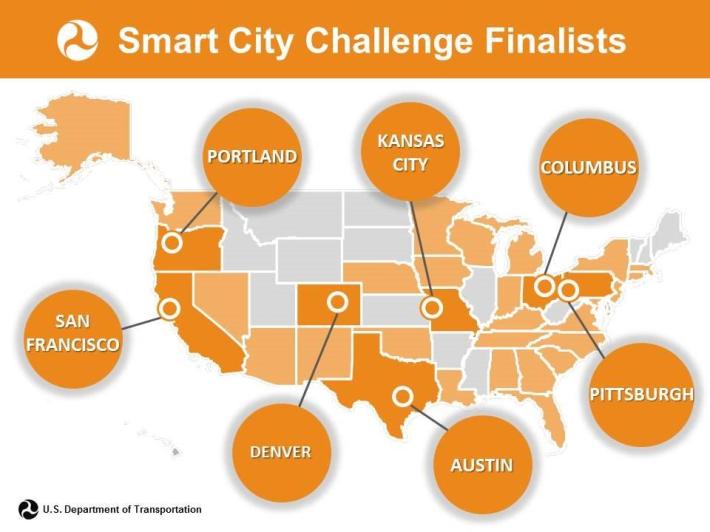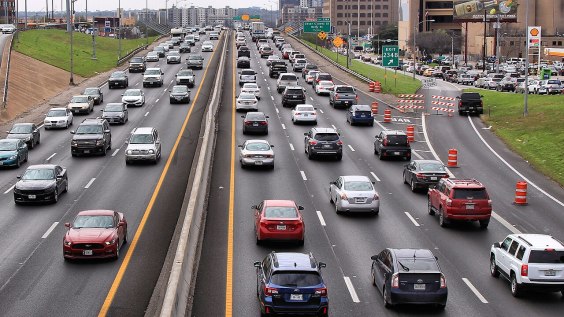
Over the weekend, San Francisco and six other finalists made it to the next round of the US Department of Transportation’s “Smart City Challenge” grant competition.
It's part of a USDOT program to get cities thinking about new technology. In a few months, USDOT will announce the winner of the ultimate prize: $50 million for implementation of the best idea for using technology to improve transportation. The award includes a $40 million grant from the government and $10 million more from Vulcan, Microsoft co-founder Paul Allen's philanthropy.
"We received applications from 78 cities that fully embraced the Challenge," wrote Transportation Secretary Anthony Foxx in a blog post. Originally, the USDOT was going to work with five cities, but the Secretary wrote that they invited two more to join. "Each of these finalists will receive $100,000 to build out their vision, including submitting budgets and expanding their proposals."
Of course, this was a perfect opportunity for SFMTA's new "Office of Innovation," led by Timothy Papandreou, Chief Innovation Officer at the San Francisco Municipal Transportation Agency. "That's why the office of innovation was created." San Francisco's proposal aims to get in front of the next phase of the sharing economy, he said. "We learned our lesson from the last couple of years." The rapid rise of Uber and Lyft taught city transportation agencies just how quickly things are changing.
He added that San Francisco's entry will have them partnering with tech, communications, and transportation companies to start planning for integration of ride-hailing with existing transit assets. "We want to make it mature so ride-hailing is folded into transit as a step towards shifting behaviors from personal cars, and to get access to everyone," he said. That means that, as shown in the USDOT video below, in the future someone who buys a Muni or Caltrain ticket will be able to get off the train and find a ride-share--perhaps one day an automated car--waiting right there.
Despite a recent small setback, self-driving cars seem tantalizingly close to ready for the road. And what will that mean for the future of transportation? Will it mean more cars? Probably not. But will these new automated cars draw people away from transit, and consume more energy in the end? That will depend. Rather than wait until the technology is in widespread use before formulating policies, as transportation agencies ended up doing with Uber and Lyft, San Francisco is hoping to shape the use of new tech to reduce Vehicle Miles Traveled and CO2 emissions.
Papandreou also envisions a day when automated vehicles respond to demand, so a five-person or fifty-person vehicle will show up depending how many people want to travel and where. By making ride-hailing more dominant, there will be less need for parking and parking structures for private automobiles, which sit around doing nothing most of the time. That will free up more room for more important uses, such as housing, he explained.

The program was aimed at mid-sized cities with an established public transportation system. Other finalists included Denver, Portland, Kansas City, Austin, Columbus, and Pittsburgh.
The USDOT even has a short animation video to explain what they're hoping to achieve with the grants.
It all seems nice, but it's still not going to substitute for good urban planning. The solution to sprawl is to reduce it, not switch to driverless cars, as the USDOT video seems to imply.
"Better transportation must first mean safer transportation--particularly for people on foot and bike, who are most at risk when involved in traffic crashes," said Natalie Burdick, Outreach Director for Walk San Francisco. That said, "It's encouraging to see the City actively pursuing additional resources to tackle its transportation needs. As improving the City's transportation system demands a multi-disciplinary approach, smart technology is certainly one aspect of the solution."
And Papandreou agrees with that; in fact, in his view, that's the overriding goal. And he hopes by reducing the number of private automobiles there will be more space for parklets, bike lanes, and housing--and driving speeds will be slowed down with automated cars. "We want to transition to meet fundamental goals, such as Vision Zero and improved walkability," he said.
Papandreou said San Francisco will move ahead with its integration plans either way "but we need the grant to give us a boost."




